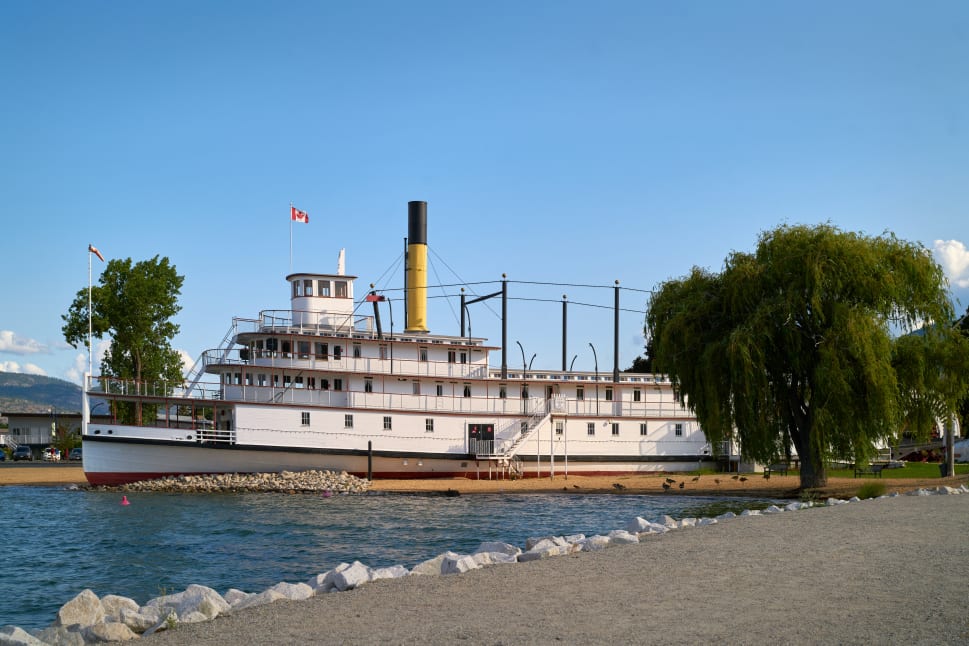Exploring Penticton's historical landmarks offers a glimpse into the rich story of the city's past. This piece highlights significant sites and their stories, showcasing the heritage and culture that shape Penticton today.
S.S. Sicamous
History and Background
The S.S. Sicamous is a significant piece of Penticton's maritime history. Launched in 1914, this sternwheeler was crucial in transporting passengers and goods across Okanagan Lake. The S.S. Sicamous was the largest vessel in a fleet operated by the Canadian Pacific Railway, connecting communities and fostering economic growth in the region.
Over the years, the S.S. Sicamous saw various changes, adapting to the needs of the communities it served. From transporting fruits and other goods to being a passenger ferry, it was an essential part of life around Okanagan Lake. Today, it stands as a symbol of Penticton's rich heritage.
Current Status and Attractions
Now permanently docked at Okanagan Lake, the S.S. Sicamous has been meticulously restored and converted into a museum. Visitors can explore its decks and learn about its storied past through detailed exhibits and displays. The museum features artifacts from the early 20th century, including navigational equipment, passenger tickets, and personal items from those who travelled aboard.
The S.S. Sicamous also hosts various events, including weddings, parties, and community gatherings, making it a living part of Penticton's cultural fabric. Special events like historical reenactments and themed tours offer an immersive experience, transporting visitors back to the ship's operational days.
The S.S. Naramata
History and Background
The S.S. Naramata is another important vessel in Penticton's maritime history. Launched in 1914, it served as a tugboat, assisting larger ships like the S.S. Sicamous in maneuvering and docking. The S.S. Naramata was a workhorse on Okanagan Lake, which was vital in transporting goods and the overall functionality of the lake's shipping operations.
Built-in Ontario and transported in pieces to be assembled on the lake, the S.S. Naramata exemplifies the ingenuity and determination of early 20th-century engineering. It remained in service for many decades, witnessing the evolution of the region's transportation needs.
Preservation and Visitor Information
Today, the S.S. Naramata is preserved alongside the S.S. Sicamous, contributing to the historical narrative of the area. Visitors can learn about the tugboat's operational history and its contributions to the development of Okanagan Lake's maritime activities. Though less extensively restored than the S.S. Sicamous, the S.S. Naramata remains a crucial piece of the historical puzzle, offering insights into its crew's hard work and daily life.
Educational panels and guided tours provide a comprehensive understanding of the tugboat's significance, making it a worthwhile stop for history enthusiasts and those interested in maritime heritage.
Penticton Museum and Archives
History and Background
Established to preserve and showcase Penticton's rich history, the Penticton Museum and Archives is a cornerstone of the city's cultural scene. The museum was founded to collect, preserve, and display artifacts that tell the story of Penticton and its people.
The museum has evolved, expanding its collections and exhibits to include various topics, from Indigenous history and early settler life to the city's industrial and recreational developments. Key figures in its establishment worked tirelessly to create a space where history is accessible and engaging for all.
Exhibits and Collections
The Penticton Museum and Archives boasts an impressive array of exhibits. Permanent exhibits include displays of the region's natural history, Indigenous artifacts, and pioneer life. Rotating exhibits always ensure something new to see, often highlighting specific themes or periods in Penticton's history.
The museum also offers educational programs and community outreach initiatives to foster a deeper understanding and appreciation of local history. Workshops, lectures, and hands-on activities make history come alive for visitors of all ages, ensuring that the stories of Penticton are preserved and passed down through generations.
Kettle Valley Railway
History and Construction
The Kettle Valley Railway is a demonstration of the engineering prowess and determination of early 20th-century Canadians. Constructed between 1910 and 1915, this railway connected the Kootenay region with the coast, passing through Penticton and significantly impacting its development. The railway was a lifeline for communities, facilitating the transport of goods and passengers across the rugged terrain.
Building the railway was no small feat, involving treacherous mountain passes and challenging weather conditions. The construction required innovative solutions and sheer hard work, resulting in a railway serving the region for many decades.
Current Use and Attractions
Today, the Kettle Valley Railway is celebrated as a historical landmark and recreational trail. Sections of the original railway have been converted into hiking and biking paths, attracting outdoor enthusiasts who appreciate the route's natural beauty and historical significance.
Special events, such as guided tours and themed rides, offer unique ways to experience the railway's history. The Myra Canyon section, with its restored trestles and tunnels, is trendy, providing stunning views and a tangible connection to the past.
The S.S. Okanagan
Historical Significance
The S.S. Okanagan played a pivotal role in the economic and social development of the Okanagan region. Launched in 1907, it was one of the earliest steamships to operate on Okanagan Lake, providing vital transport links for people and goods. The S.S. Okanagan was involved in significant historical events, including transporting soldiers during World War I and facilitating regional trade.
As a passenger ship, it was a vital part of the travel network, enabling people to move around and contributing to the growth of tourism in the area. Its impact on the region's development is still remembered today.
Legacy and Remnants
While the S.S. Okanagan no longer exists, its legacy lives on through photographs, stories, and remaining artifacts. The vessel's contributions to the region are commemorated at local museums and historical sites. Visitors can learn about its storied past and its role in shaping the Okanagan Valley.
Efforts to preserve its memory include detailed exhibits and educational programs highlighting the steamship's importance. These initiatives ensure that the S.S. Okanagan remains celebrated in Penticton's maritime history.
The Cannery Trade Centre
Historical Background
The Cannery Trade Centre has a rich history rooted in Penticton's agricultural and industrial past. Originally a fruit and vegetable canning facility, it played a vital role in the local economy, processing and distributing produce from the surrounding orchards and farms.
The transformation from an industrial site to a community hub showcases the adaptive reuse of historical buildings. Preserving its architectural integrity, the Cannery Trade Centre now serves a new purpose while honouring its past.
Current Use and Community Impact
Today, the Cannery Trade Centre is a bustling marketplace and community space. It houses a variety of businesses, including artisanal shops, restaurants, and offices. The centre supports local entrepreneurs and artists, providing a space for commerce and creativity.
Community events like farmers' markets and cultural festivals are regularly held at the Cannery Trade Centre, drawing residents and visitors alike. The centre's role in the community has evolved, but its historical significance and impact remain strong.
Conclusion
Penticton's historical landmarks offer a fascinating journey through time, showcasing the city's rich heritage and cultural diversity. From the majestic S.S. Sicamous and the industrious S.S. Naramata to the educational Penticton Museum and Archives, these sites tell the story of a community shaped by its history. Exploring these landmarks provides valuable insights into the past and a deeper appreciation for the present.
Visiting these historical sites will enrich your understanding of Penticton and its place in the broader narrative of the Okanagan region.



